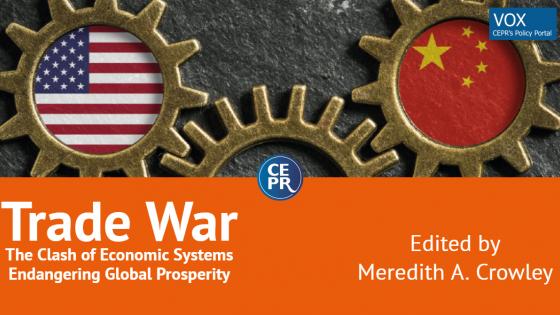A trade war of unprecedented scope and magnitude currently engulfs the world’s two largest economies – the US and China. As of mid-May 2019, the US had imposed import tariffs on roughly $250 billion of Chinese goods, China had met the US with retaliatory tariffs on $110 billion of US merchandise, and talks to resolve the conflict appear to have broken down. As the US-China conflict continues, American trade relations with the EU and Japan are strained. Donald Trump’s threat to impose tariffs on autos and auto parts overshadows tri-party and bilateral discussions.
What happened to get us here? Over the last 20 years, trade globalisation has increased welfare in the US (Feenstra and Weinstein 2017) and improved productivity in China (Yu 2015). But while these gains have been substantial, the costs imposed on displaced US manufacturing workers have also been severe (Autor et al. 2013). A new eBook seeks to shed light on the origins of the Sino-American economic conflict, the current impacts of the conflict on economic activity around the world, and the likely consequences for the future of globalisation (Crowley 2019). It is a story in three acts, beginning with the accession of China to the WTO, tracing through the story of how China’s development and economic integration through global trade led to the world’s largest trade conflict in decades, and ending with questions about whether the rules-based multilateral trading system will survive and flourish or stagnate and fumble in an environment of uncertainty over future economic policy cooperation.
Download the VoxEU eBook, Trade War: The Clash of Economic Systems Endangering Global Prosperity, here
The origins of the US-China trade conflict
Three essays explore the origins of the US-China trade war. Justin Pierce and Peter Schott examine how import competition from China contributed to geographically concentrated declines in US manufacturing employment. Although China’s entry into the WTO created substantial welfare gains for the average American (Amiti et al. 2017), those Americans who lost their jobs from import competition have never fully recovered.
But why did the US instigate a bilateral trade war to address concerns over trade with China? Why not resolve problems through the WTO’s dispute settlement system? Chad Bown outlines the US’s long-standing concerns with multiple aspects of Chinese economic policy – China’s domestic industrial and technology policies as well as the structure of Chinese state-sponsored capitalism. In bringing to light the perceived failure of WTO dispute settlement to satisfy US concerns – including a history of legal decisions against the US that did not involve China – Bown helps us to understand the motivation behind the radical decision by the US to abandon multilateral trade negotiation in favour of a bilateral trade war.
Why would the US, the world’s largest and most significant economic power, choose to throw away a rules-based trading system that has served its interests for decades in favour of power-based bilateral bargaining with the world’s second largest economy? Aaditya Mattoo and Robert Staiger argue that long-term changes in the relative positions of the US and China in the world economy are the deep drivers behind the eruption of the US-China trade conflict. They frame the shift in US policy as the consequence of a decline in US hegemony over the global economy.
The costs of trade wars
Four contributions quantify the economic costs of import tariffs and trade wars and discuss the uneven distribution of losses across countries, producers, and consumers. Ralph Ossa estimates the magnitude of the economic welfare losses associated with trade conflicts of different scopes – from a bilateral US-China conflict to a worst-case scenario global trade war. A key insight from his analysis of an all-out global trade war is that the estimated real income losses to the US, the EU, and China of about -2% each are far smaller than the estimated damage to smaller countries like Switzerland (-14%), Mexico (-7%), and Canada (-7%).
Doireann Fitzgerald discusses two important studies of the immediate impact of the US-China trade war by Amiti et al. (2019) and Fajgelbaum et al. (2019). Both studies find, somewhat surprisingly, the complete pass-through of US tariffs to US importers. In other words, the Chinese exporters who continued to sell their goods to the US after the tariffs were imposed did not reduce their prices to soften the blow to their customers.
These finding are surprising in light of previous empirical work on optimal tariffs and firms’ pricing responses to exchange rate movements. Optimal tariff research has found that governments set higher tariffs when the cost of the tariff can be (at least partially) shifted onto exporters (Broda et al. 2008, Bown and Crowley 2013, Bagwell and Staiger 2011). A new study shows Chinese exporters respond to exchange rate fluctuations by adjusting export prices and destination-specific markups (in producer’s currency) in order to stabilise their prices (in local currency) in foreign markets (Corsetti et al. 2019). Although the tariff costs of the US-China trade war have been entirely born by US importers to date, these studies suggest that, as the trade war persists, export prices could begin to adjust.
Global value chains (GVCs) complicate efforts to predict which countries and firms will suffer the greatest losses or enjoy the largest benefits from a trade war that simultaneously raises the cost of imported inputs, reduces competitive pressures on import-competing firms, and restricts the foreign market access of exporters. Emily Blanchard’s chapter suggests that because the trade war creates incentives for firms to restructure their supply networks, the long run consequences of the trade war could persist far into the future. Yi Huang, Chen Lin, Sibo Liu, and Heiwai Tang document that indirect exposure to the trade war through supply chains led to losses for US firms.
Does the multilateral trading system have a future?
Predicting the next twists and turns in the US-China conflict may be impossible, but there are signals that actions taken to date will have long-term repercussions, even if the tariff war ends soon. The contribution by Kyle Handley and Nuno Limao casts a long shadow over the hopes that wounds caused by the US-China trade war could quickly heal. They review research which implies that increases in global trade policy uncertainty could have long term negative impacts on trade and investment. Until confidence in the world trading system to deliver stable trade policy is restored, the uncertainty costs of this trade war are likely to linger.
The thorny issue of market access is taken up by economists Simon Evenett and Johannes Fritz and legal scholar Luca Rubini. Evenett and Fritz document that the hot trade war of 2018-2019 is part of a much longer trend of bilateral reductions in market access by the US and China, while Rubini examines the controversial history of WTO jurisprudence on subsidies and explains why the WTO’s subsidy rules no longer have any legal bite.
The eBook wraps up with Mark Wu’s analysis of the clash of economics systems at the heart of the US-China quarrel. Wu explains how certain aspects of China’s unique form of state capitalism, such as informal networks, the Chinese Communist Party’s influence over an individual’s career progression, and implied rather than formal requirements, mean that attempts to seek redress for perceived unfair practices through WTO dispute settlement are unlikely to succeed. In the absence of an effective WTO mechanism that could put pressure on China to reform certain practices, what options remain for Western countries? Until this question is addressed, restrictions on market access, import tariffs, and accusations of unfair practices are unlikely to go away.
Conclusion
This volume constructs a narrative of the US-China Trade War as the outgrowth of long-brewing tensions in the multilateral trading system. Multiple factors – the unprecedented economic growth of an economy operating outside the traditional Western capitalist model, new structures of production with supply chains spanning the globe, geographically concentrated job losses within the US, and a multilateral trading system that has stagnated and failed to keep pace with changes in the world economy – have all contributed to the current mess. The problems extend well beyond the highly visible US-China conflict to the wider community of countries struggling with the interface between Chinese state capitalism and their own capitalist systems, the failure of the WTO to make progress with multilateral negotiations over almost anything, and a dispute resolution system that has veered off track.
From our current vantage point, the prospects for the future of the multilateral trading system look grim. Unfortunately, the list of potentially effective avenues for achieving substantive reform is short and will require concerted efforts and serious compromises. The difficult question of how to integrate the fundamentally different economic systems of Western liberal capitalism and Chinese state capitalism has no easy answers. The question for policymakers today is whether the multilateral trading system, which fostered tremendous economic welfare gains for so many in the past, can be redeveloped and renewed in order to continue its legacy of delivering economic prosperity into the future.
References
Amiti, M, M Dai, R Feenstra and J Romalis (2017), “How Did China’s WTO entry benefit US Consumers?”, CEPR Discussion Paper 12076.
Amiti, M, S J Redding and D Weinstein (2019), “The Impact of the 2018 Trade War on US Imports and Prices,” CEPR Discussion Paper 13564.
Autor, D H, D Dorn, and G H Hanson (2013), "The China Syndrome: Local Labor Market Effects of Import Competition in the United States", American Economic Review 103(6): 2121-68.
Bown, C P and M A Crowley (2013), “Self-Enforcing Trade Agreements: Evidence from Time-Varying Trade Policy”, American Economic Review 103(2): 1071-90.
Broda, C, N Limao and D Weinstein (2008), “Optimal Tariffs and Market Power: The Evidence”, American Economic Review 98(5): 2032-65.
Corsetti, G, M Crowley, L Han and H Song (2018), “Markets and Markups: A New Empirical Framework and Evidence on Exporters from China”, Cambridge-INET Working Paper Series No. 2018/05.
Crowley, M A (2019), Trade War: The Clash of Economic Systems Threatening Global Prosperity, CEPR Press.
Fajgelbaum, P D, P K Goldberg, P J Kennedy and A Khandelwal (2019), “The Return to Protectionism,” NBER Working Paper 25638.
Feenstra, R and D Weinstein (2017), “Globalization, Markups, and U.S. Welfare”, Journal of Political Economy 125(4): 1041-1074.
Yu, M (2015), “Processing Trade, Tariff Reductions and Firm Productivity: Evidence from Chinese Firms”, The Economic Journal 125(585): 943–988.



